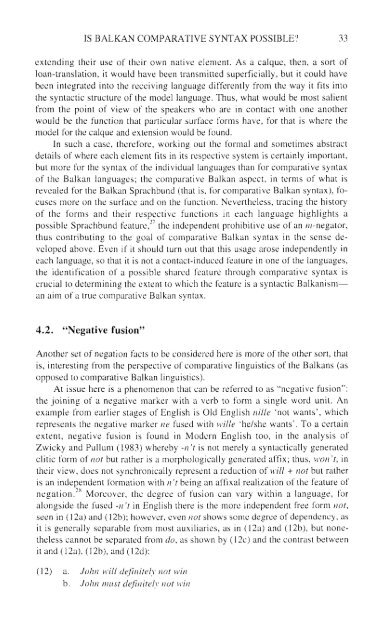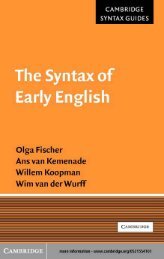Comparative Syntax of the Balkan Languages (Oxford ... - Cryptm.org
Comparative Syntax of the Balkan Languages (Oxford ... - Cryptm.org
Comparative Syntax of the Balkan Languages (Oxford ... - Cryptm.org
- No tags were found...
You also want an ePaper? Increase the reach of your titles
YUMPU automatically turns print PDFs into web optimized ePapers that Google loves.
IS BALKAN COMPARATIVE SYNTAX POSSIBLE 1 ' 33extending <strong>the</strong>ir use <strong>of</strong> <strong>the</strong>ir own native element. As a caique, <strong>the</strong>n, a sort <strong>of</strong>loan-translation, it would have been transmitted superficially, but it could havebeen integrated into <strong>the</strong> receiving language differently from <strong>the</strong> way it fits into<strong>the</strong> syntactic structure <strong>of</strong> <strong>the</strong> model language. Thus, what would be most salientfrom <strong>the</strong> point <strong>of</strong> view <strong>of</strong> <strong>the</strong> speakers who are in contact with one ano<strong>the</strong>rwould be <strong>the</strong> function that particular surface forms have, for that is where <strong>the</strong>model for <strong>the</strong> caique and extension would be found.In such a case, <strong>the</strong>refore, working out <strong>the</strong> formal and sometimes abstractdetails <strong>of</strong> where each element fits in its respective system is certainly important,but more for <strong>the</strong> syntax <strong>of</strong> <strong>the</strong> individual languages than for comparative syntax<strong>of</strong> <strong>the</strong> <strong>Balkan</strong> languages; <strong>the</strong> comparative <strong>Balkan</strong> aspect, in terms <strong>of</strong> what isrevealed for <strong>the</strong> <strong>Balkan</strong> Sprachbund (that is, for comparative <strong>Balkan</strong> syntax), focusesmore on <strong>the</strong> surface and on <strong>the</strong> function. Never<strong>the</strong>less, tracing <strong>the</strong> history<strong>of</strong> <strong>the</strong> forms and <strong>the</strong>ir respective functions in each language highlights apossible Sprachbund feature,"' <strong>the</strong> independent prohibitive use <strong>of</strong> an m-negator,thus contributing to <strong>the</strong> goal <strong>of</strong> comparative <strong>Balkan</strong> syntax in <strong>the</strong> sense developedabove. Even if it should turn out that this usage arose independently ineach language, so that it is not a contact-induced feature in one <strong>of</strong> <strong>the</strong> languages,<strong>the</strong> identification <strong>of</strong> a possible shared feature through comparative syntax iscrucial to determining <strong>the</strong> extent to which <strong>the</strong> feature is a syntactic <strong>Balkan</strong>ism—an aim <strong>of</strong> a true comparative <strong>Balkan</strong> syntax.4.2. "Negative fusion"Ano<strong>the</strong>r set <strong>of</strong> negation facts to be considered here is more <strong>of</strong> <strong>the</strong> o<strong>the</strong>r sort, thatis, interesting from <strong>the</strong> perspective <strong>of</strong> comparative linguistics <strong>of</strong> <strong>the</strong> <strong>Balkan</strong>s (asopposed to comparative <strong>Balkan</strong> linguistics).At issue here is a phenomenon that can be referred to as "negative fusion":<strong>the</strong> joining <strong>of</strong> a negative marker with a verb to form a single word unit. Anexample from earlier stages <strong>of</strong> English is Old English nille 'not wants', whichrepresents <strong>the</strong> negative marker ne fused with wille 'he/she wants'. To a certainextent, negative fusion is found in Modern English too, in <strong>the</strong> analysis <strong>of</strong>Zwicky and Pullum (1983) whereby -n't is not merely a syntactically generatedclitic form <strong>of</strong> not but ra<strong>the</strong>r is a morphologically generated affix; thus, won't, in<strong>the</strong>ir view, does not synchronically represent a reduction <strong>of</strong> will + not but ra<strong>the</strong>ris an independent formation with n't being an affixal realization <strong>of</strong> <strong>the</strong> feature <strong>of</strong>negation." Moreover, <strong>the</strong> degree <strong>of</strong> fusion can vary within a language, foralongside <strong>the</strong> fused -n't in English <strong>the</strong>re is <strong>the</strong> more independent free form not,seen in (12a) and (12b); however, even not shows some degree <strong>of</strong> dependency, asit is generally separable from most auxiliaries, as in (12a) and (12b), but none<strong>the</strong>lesscannot be separated from do, as shown by (12c) and <strong>the</strong> contrast betweenit and(12a), (12b), and (12d):(12) a. John will definitelv not winb. John must definitely not win
















